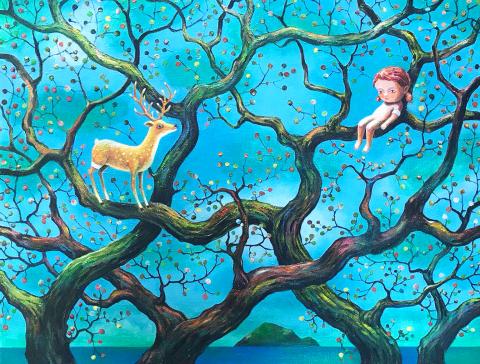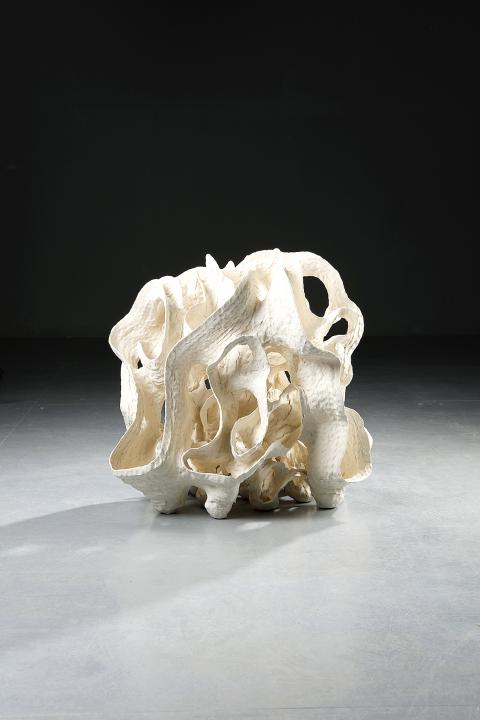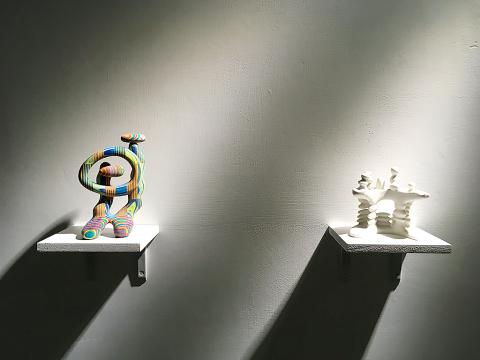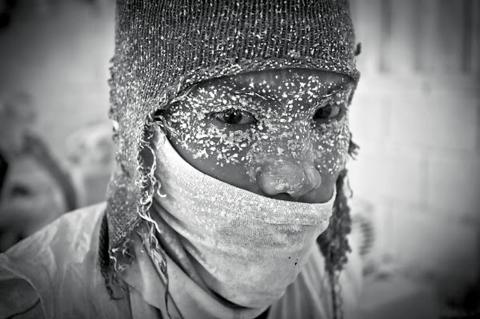Eslite Gallery presents One Plus One (壹加壹), a solo show by Taiwanese artist Michael Lin (林明弘). Lin is known for creating monumental painting projects that incorporate Taiwanese textile patterns. He quotes Paris-based art historian Vivian Rehberg when defining painting as “a bounded physical space [in which] one we can settle into and inhabit.” By staging his gigantic paintings at public art institutions, Lin hopes to encourage viewers to reconsider the nature of these public spaces and our relationship to them. His current show at Eslite is a collaborative presentation between himself, Swiss visual artist Beat Streuli, Roan Ching-yue (阮慶岳) and David Yu (余大衛). The show adopts the structure of a montage, in which different narratives are juxtaposed or reconfigured in different arrangements. The show begins with Streuli’s portrait of “Taipei urbanites.” Lin’s textile patterned painting stands erect in the middle of the first room while also serving as a structural support for Streuli’s billboard-size photographs. In the second room, Streuli’s collage and video projection serve as support for Lin’s work on canvas. The show also includes Yu’s display of collected products chosen from the Eslite Bookstore and Roan’s writings. As a whole, the exhibition strives to make “transparent the relationships of the site and locality, contemporary art and business, promotion and publicity.”
■ Eslite Gallery (誠品畫廊), 5F, 11 Songgao Rd, Taipei City (台北市松高路11號5樓), tel: (02) 8789-3388. Open Tuesdays to Sundays from 11am to 7pm
■ Until Nov. 25

Photo Courtesy of Eslite Bookstore
Casting Stones Into Still Water (靜水蕩漾) is a group exhibition that showcases 15 Filipino female artists. The show is curated by Patrick Flores, an art professor at the University of the Philippines and Curator of the Vargas Museum in Manila. For this exhibition, Flores asked the artists to respond to an installation that Filipino artist Ileana Lee created in the 70’s. In that work, Lee explores the exhibition space by neatly placing strips of tape onto the floor, walls and ceiling, creating contours that mark different areas and conceptually “claim space for the woman artists in the art world,” writes the gallery in a press release. The artists in this show were encouraged to reflect on the issue of boundaries and the claiming of space. Nana Buxan’s Jason Roxas/Marble Worker is a photo of a manual worker whose eyes are covered by powder and face partially covered by a knit hat and mask. Marina Cruz works with painting and embroidery to examine domestic spaces. She focuses on mundane chores like cooking and doing laundry, which according the curator, involves the dynamic relationship between the interior and exterior.
■ Mind Set Art Center (安卓藝術) 108, Heping E Rd, Taipei City (台北市和平東路108號), tel: (02) 2365-6008. Open Tuesdays to Saturdays from 11am to 6pm
■ Until Dec. 8

Photo Courtesy of Double Square Gallery
Hsu Yung-hsu is a Taiwanese ceramic artist with a background in Chinese zither music. Working as an elementary school teacher in the 70s, Hsu founded his own ceramic studio in the 80’s and eventually left his teaching job and music career to become a full-time artist in the late 90’s. In the last three decades, Hsu “steadfastly nurtured a symbiotic union between himself and clay as well as the depth of their dialogue to create his unique sculptural style,“ according to the gallery’s press release. His current show, Unfettered Encompassment (大器逍遙), presents 25 sculptures created in the last four years. Hsu’s work involves a laborsome process of treating clay, where he “constantly and repeatedly presses, compresses, squeezes, tears, pinches, pokes, rubs, piles and pushes to create desired shapes before layering them up to form his sculptures,” writes the gallery. The resulting work is covered with countless hand prints, a testament to his intimate struggle and dialogue with his material. The shape of Hsu’s sculptures suggests organic forms such as sea creatures, ribbon-like fiber, shells or rice husks.
■ Double Square Gallery (雙方藝廊), 28, Lane 770, Beian Road, Taipei City (台北市北安路770巷28號), tel: (02) 8501-2138. Open Tuesdays to Sundays from 10:30am to 6:30pm
■ Until Dec. 8

Photo Courtesy of Taipei Art Village
Jungle (叢林) is a group exhibition that uses the jungle as a metaphor for the state of modern city living. Curated by artist Ni Hao (倪灝), the show includes the works of 10 artists who together tackle the many issues concerning 21st century technology, social history, virtual spaces and the developments of globalization. “From Singapore’s shores to its nocturnal zoo; [from] an abandoned mine in upstate New York to cyber space; [from] military dependents’ villages in Pingtung to Rwanda, [from] Latin America and beyond… artists in this show investigate a common sense of displacement, confusion and entrapment,” writes Ni. The show is a selection of paintings, drawings, photos, installation, sculptures and videos that share the perspective of different social dimensions, including that of a flight attendant, peace keeper, domestic helper, post-apocalyptic data miner, oil painter and surveillance camera. American artists Maggie Hazen and Chris Papa present a collaborative film that narrates the story of a survivor in a post-apocalypse world searching for the remaining traces of humanity. Mark Nilsson’s paintings are a reflection of his experience in Taiwan, especially his area of residence, Chaozhou in Pingtung County. “Working from life, and painting fast with full-bodied paint, I make repeated trips to such places, painting the relevant people, places and things,” writes the artist.
■ Barry Room, Taipei Artist Village (台北國際藝術村百里廳), 7 Beiping E Rd, Taipei City (台北市北平東路7號), tel: (02) 3393-7377. Open Tuesdays to Sundays from 11am to 9pm
■ Until Nov. 25

Photo Courtesy of Mind Set Art Center
Jimmy Liao, known by his pen name Ji Mi (幾米), is a popular illustrator who became a household name in Taiwan during the late 90’s. Before becoming a full-time illustrator and writer, Liao spent 12 years working in advertising. A cancer diagnosis and experience with chemotherapy led him to eventually change his outlook on life. Liao has described drawing as therapy, which he says relaxes him. Over the last two decades, Ji Mi has published over 60 works, many of which have been recognized by international awards and adapted into commercial movies and plays. Many of his stories have also inspired public art projects, including Taipei’s Nangang MRT Station and the Moon Bus, a revamped vehicle stationed across from Taipei 101. To celebrate the 20th anniversary of Ji Mi’s first publication, a selection of his original drawings, paintings and sculptures are on view at Eslite Xinyi Bookstore starting tomorrow. A book compilation of more than 50 of his works will also be available at the bookstore. Be sure to catch the book-signing event scheduled for this Sunday from 3pm to 5pm.
■ Eslite Xinyi Bookstore 6F Multifunctional Hall (誠品信義店 6F展演廳), 11, Songgao Rd, Taipei City (台北市信義區松高路11號), tel: (02) 8789-3388. Open Daily from 11am to 9:30pm.
■ Until Nov. 25

This month the government ordered a one-year block of Xiaohongshu (小紅書) or Rednote, a Chinese social media platform with more than 3 million users in Taiwan. The government pointed to widespread fraud activity on the platform, along with cybersecurity failures. Officials said that they had reached out to the company and asked it to change. However, they received no response. The pro-China parties, the Chinese Nationalist Party (KMT) and Taiwan People’s Party (TPP), immediately swung into action, denouncing the ban as an attack on free speech. This “free speech” claim was then echoed by the People’s Republic of China (PRC),

Exceptions to the rule are sometimes revealing. For a brief few years, there was an emerging ideological split between the Democratic Progressive Party (DPP) and Chinese Nationalist Party (KMT) that appeared to be pushing the DPP in a direction that would be considered more liberal, and the KMT more conservative. In the previous column, “The KMT-DPP’s bureaucrat-led developmental state” (Dec. 11, page 12), we examined how Taiwan’s democratic system developed, and how both the two main parties largely accepted a similar consensus on how Taiwan should be run domestically and did not split along the left-right lines more familiar in

Specialty sandwiches loaded with the contents of an entire charcuterie board, overflowing with sauces, creams and all manner of creative add-ons, is perhaps one of the biggest global food trends of this year. From London to New York, lines form down the block for mortadella, burrata, pistachio and more stuffed between slices of fresh sourdough, rye or focaccia. To try the trend in Taipei, Munchies Mafia is for sure the spot — could this be the best sandwich in town? Carlos from Spain and Sergio from Mexico opened this spot just seven months ago. The two met working in the

Many people in Taiwan first learned about universal basic income (UBI) — the idea that the government should provide regular, no-strings-attached payments to each citizen — in 2019. While seeking the Democratic nomination for the 2020 US presidential election, Andrew Yang, a politician of Taiwanese descent, said that, if elected, he’d institute a UBI of US$1,000 per month to “get the economic boot off of people’s throats, allowing them to lift their heads up, breathe, and get excited for the future.” His campaign petered out, but the concept of UBI hasn’t gone away. Throughout the industrialized world, there are fears that